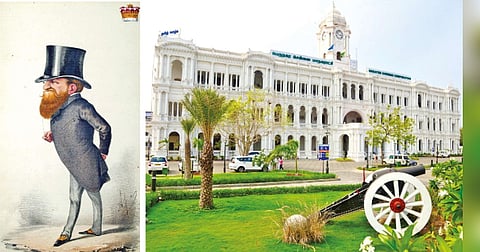

CHENNAI: Power struggles rarely give rise to constructive development. But the creation of the headquarters of the Madras Corporation was one of those rare occurrences.
Madras was being ruled, rather autocratically, by a British-American colonial administrator and slave trader President Elihu Yale (1649-1721). It is after him that the Ivy League Yale University is named.
To clip Yale’s wings, the Chairman of the East India Company, Joshua Child conceived a Corporation to create an alternative power centre. However, the reason that was given was that the growing city had an unwieldy budget and that there was a need for a formal body of local government.
The city was earlier administered by an Adhikari (supervisor), a Kanakkapulle (auditor) and Pedda Nayak (police) like other cities in the subcontinent. Yale obeyed the orders as it came in the form of a Royal Charter issued by King James II in 1687.
Interestingly, Indians were included as members of the multi-racial Corporation of Madras headed by the Worshipful Mayor.
After a few centuries within the Fort, the Corporation office moved to Errabalu Street in Black Town, where a private building was rented. Later, the government decided to give the Madras Corporation 1,00,000 square feet of its own office space – where a structure befitting its status could be run.
The government decided to hive off a portion of the massive People’s Park for this purpose.
The building still retains the name of a British politician – George Frederick Samuel Robinson, the 1st Marquess of Ripon (a cathedral city in England). He is better known by his title — Lord Ripon. Having served as the Viceroy and the Governor General of India, he executed some landmark legislations, many favouring the natives.
The highly-organised self rule movements mushroomed in India soon after his stint. When Ripon had become Viceroy, he shocked many with his Ilbert Bill, which while granting Indians more legal rights, also included the clause that Europeans could be tried by Indian judges in the court of law.
His Factory Act granted weekly holidays to workers, along with an hour of rest during the work day and four days of leave in a month and forbade children under the age of seven to work in factories and mines.
Ripon is best known for the Resolution of 1882, which gave Indians the right to local self-government.
The scheme would go on to develop the local self-governing bodies in the rural and urban areas. It’s why many historians consider him the ‘Father of Local-Self Government in India’.
The foundation stone for the Ripon Building was laid by Lord Minto, the Viceroy of India, on December 11, 1909. Ripon’s death in July that year might have prompted the government to name the building after him. It was not an act of sycophancy, as it had been 25 years since Ripon served as Viceroy.
The building was all white, standing out in the horizon, distinct from its two neighbours, the red tinted Indo Saracenic buildings, the Victoria Public Hall and the Central Station. It was designed by government architect GTS Harris.
In a move away from the prevailing Indo Saracenic architectural style which included Indian elements, the Ripon Building was built in the classical style and looks more like a European building than any of its counterparts. It even had an eight feet tall central clock tower whose chime sounded like that of the Big Ben in London, perhaps to alleviate the homesickness felt by the British in Madras.
P Loganatha Mudaliar, a Bangalore based developer took on this project which was his biggest and most challenging. The construction had to be carried out on a swampy plot where the soil was soggy, thanks to Cooum and the North River (the Buckingham Canal) in the vicinity.
Changing the whole soil was out of the question and Mudaliar opted to firm up the foundation with sunken terracotta wells filled with concrete-like material.
To offer natural illumination to the areas furthermost from the windows, two courtyards were incorporated. Roman style decorated columns and arches were built using just brick and lime.
Bricks were transported on shallow boats from Choolaimedu. Each floor was topped with a Madras Terrace roof.
The inauguration of the building in 1913 was one of the well-attended events held in colonial Madras with 3,000 invitees.
A statue of Lord Ripon, originally located on Mount Road, was moved to the Corporation lawn decades later. Initially, the Corporation head was referred to as the President. In 1919, Madras appointed its first native President Pitti Theagaraya Chetty after whom T Nagar is named. Then, in the 1930s, the post of the Mayor was revived. Three sons of Raja Sir Annamalai Chettiar have served as Mayors.
They presented the Mayor’s furniture as a gift to the Corporation. The chair was based on the design of the Speaker’s seat in the British House of Commons. They also presented a 125-sovereign gold chain and a silver sceptre as an adornment for the Mayor.
Prominent politicians have held the post of the Mayor, which proved as stepping stones to greater positions.
Some of them made lasting changes in their one-year terms. SS Sathyamurthy in the 1940s created the Poondi Reservoir while Vengal Chakkarai Chetty had an uneviable task of ordering all the dangerous animals of the Madras Zoo to be shot dead amid the Japanese bombing scare of 1942.
Today a new five-storey annexe on the premises takes the load off the Ripon Building. With the passage of time, the Ripon Building had developed cracks that were compounded by the Chennai Metro Rail works. A major renovation initiative has brought it back to its original glory.
— The writer is a historian and an author
Visit news.dtnext.in to explore our interactive epaper!
Download the DT Next app for more exciting features!
Click here for iOS
Click here for Android